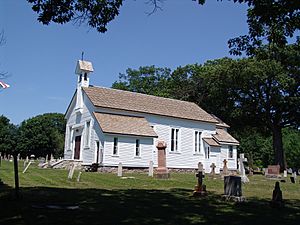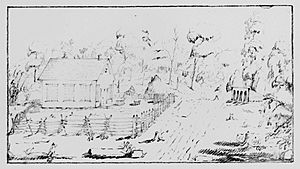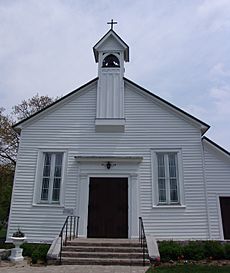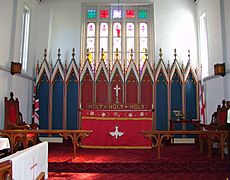St. James on-the-Lines facts for kids
Quick facts for kids St. James on-the-Lines |
|
|---|---|
 |
|
| 44°47′13″N 79°55′34″W / 44.78694°N 79.92611°W | |
| Location | Penetanguishene, Ontario |
| Country | Canada |
| Denomination | Anglican |
| History | |
| Status | Parish church |
| Architecture | |
| Functional status | Active |
| Heritage designation | Ontario Heritage Trust |
| Designated | Jan. 20 1981 |
| Style | Greek Revival with Gothic Revival elements |
| Groundbreaking | 1836 |
| Completed | 1840 |
| Administration | |
| Parish | Penetanguishene |
| Episcopal area | York-Simcoe |
| Diocese | Anglican Diocese of Toronto |
St. James on-the-Lines is a very old and special Anglican church. It is located in Penetanguishene, Ontario, Canada. This historic church is still used today for services. People attend from Easter until Thanksgiving. The church is protected as a heritage site. This means it is an important part of history.
The church's name has two possible meanings. One idea is that it was built along the "lines of communication." This was a road leading from the old military base. The second idea comes from an old military term. "Lines" used to mean rows of tents or buildings in a military camp. The church was built near these military buildings.
Contents
Church History: St. James
The church was built a long time ago, between 1836 and 1840. Colonel James Keating was a military leader. He wanted a church for the soldiers. He helped get land for the church. Most of the money for building came from Captain John Moberly. He was in charge of the Penetanguishene Naval Yard. Both Keating and Moberly are buried in the church's cemetery.
The first church leader was Rev. George Hallen. He worked there for 36 years. He is also buried in the cemetery. The military base closed in 1856. The building then became a school for boys. Hallen became the chaplain there. The church continued to hold services. Townspeople, farmers, and retired soldiers attended. It was the only Protestant church in the area until the 1870s.
In 1981, the Ontario Heritage Trust protected the church. This made it a historic site. People raised money to fix up the building. It needed repairs because it was so old. The restoration work was finished by 1985.
Another Anglican church, All Saints, opened in 1877. For many years, the two churches had separate services. But in 1997, they started working together. Now, they hold summer services at St. James. Winter services are held at All Saints. The two churches officially joined together in 2008.
Building the Church: Design and Style
Outside Look: Exterior Features
The church is made of wood. It has clapboard siding. It sits on a stone foundation. Its style is Greek Revival. But it also has some Gothic Revival parts. The first design was only Greek Revival. It had just one room.
In 1840, Bishop Strachan wanted the church to look more like an English church. So, Gothic elements were added. The entrance was changed. A small bell tower was added to the west end. This bell tower has Gothic arches and special designs. Later, more rooms were added. These included a chancel, sanctuary, and vestry. The main entrance door has fancy metal hinges. These were made by skilled workers from the military base.
Inside Look: Interior Features
Inside the church, a special feature is a colorful wooden screen. It is called a reredos. This screen is behind the altar. It was added around the 1870s. The church has a very wide center aisle. This was so soldiers could march out four abreast after services.
Each row of pews was built by different military members. So, each pew has its own unique design. The pews at the front have more detailed carvings. These were for the officers.
On one wall, there is a wooden memorial plaque. It has two parts. One part remembers Lieutenant William Glascott. He passed away after an accident while returning from a fun evening. The other side of the plaque is blank. One story says it was for another officer. This officer was with Glascott and was expected to pass away too. But he recovered and moved away. Another story says the blank side was a warning to soldiers. It reminded them to be careful. It showed that their name could be added if they were not.





